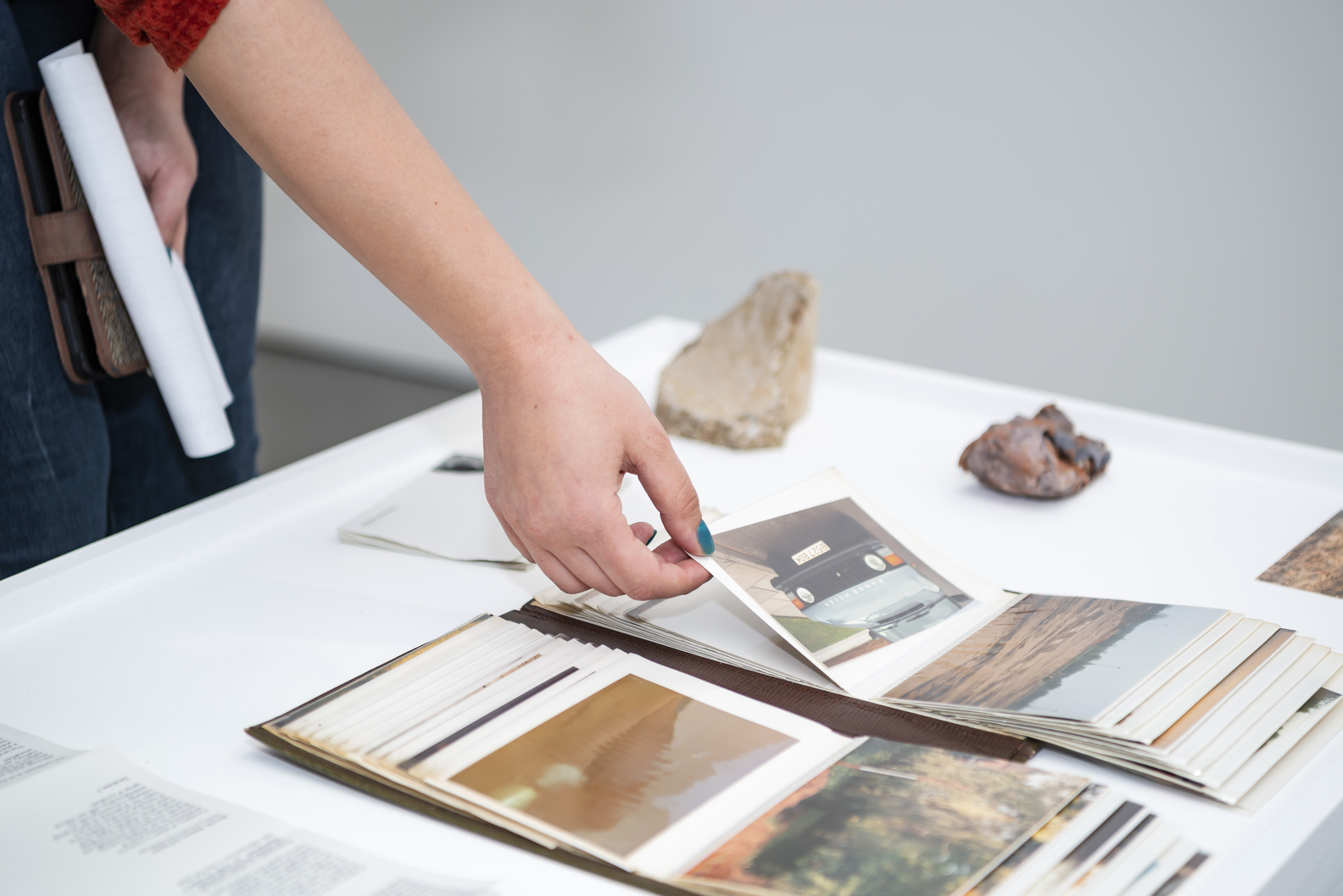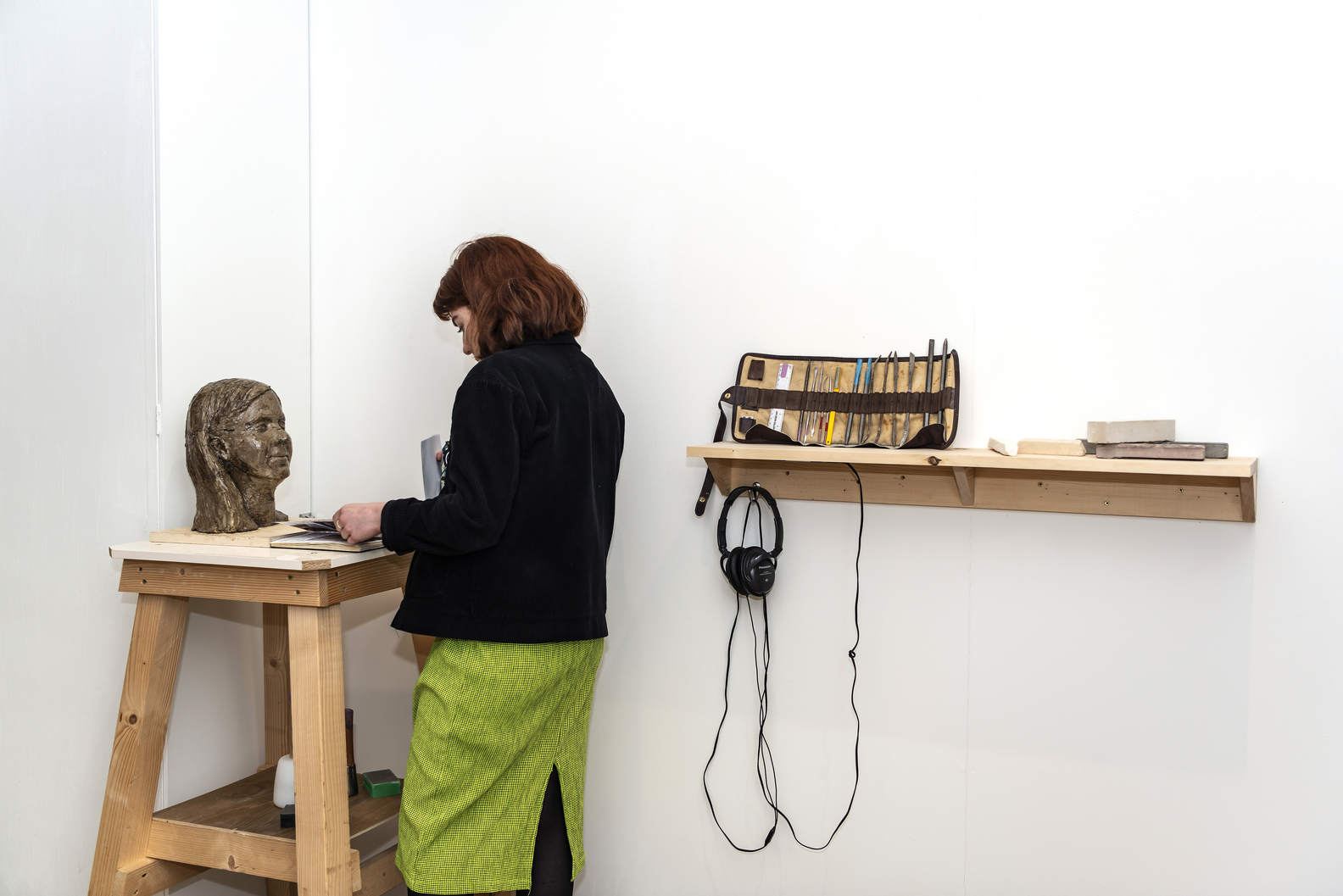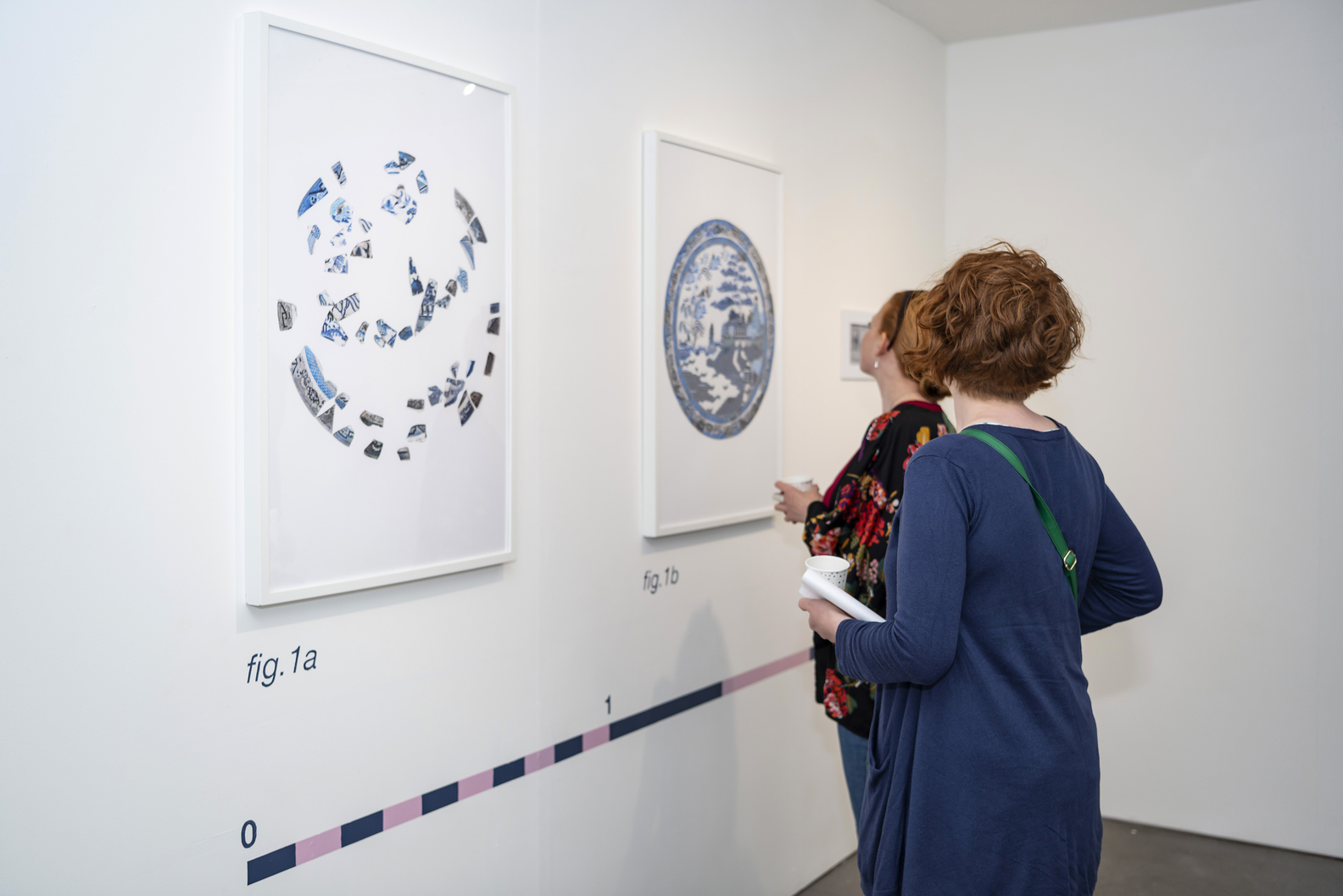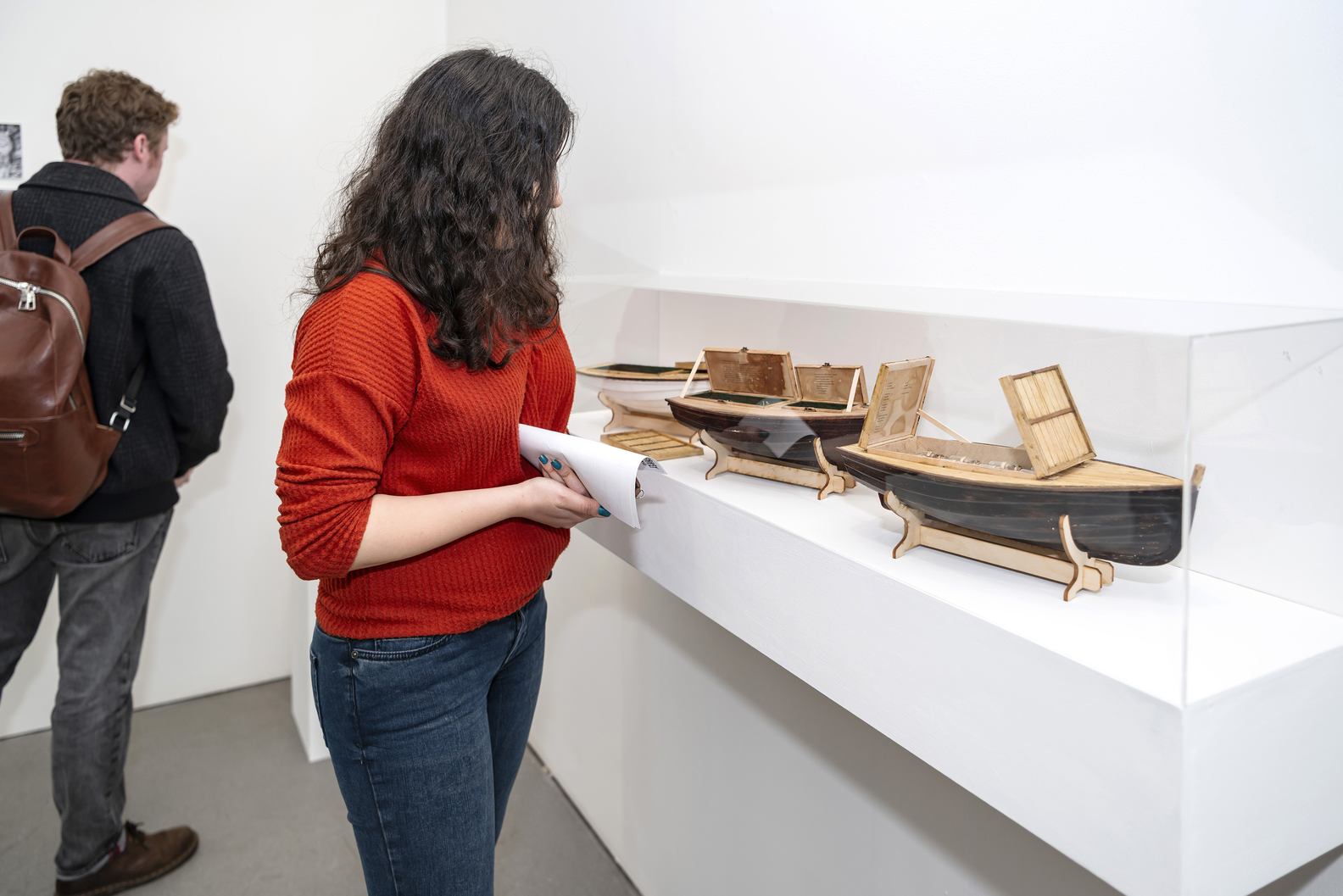Situating Practices was an exhibition which took as its premise the relationship between visual art practice and research within an academic context. Drawing on the interests of curator Claire Booth-Kurpnieks in the convergences of social science and art, the exhibition asked how we might understand research which is derived from, and articulated through, different forms of artistic practice.
The exhibition was located within the Market Gallery, a white cube style exhibition space repurposed from vacant stalls within Queensgate Market, with additional site-specific interventions across the market hall. Organised as part of the Temporary Contemporary programme, Situating Practices was comprised of works by postgraduate researchers working in, with, and through art practice, and explored how the context of the gallery space, in the production and dissemination of practice-based research, facilitates new dialogues and encounters between the work of art and the public. Concepts of labour and process were also foregrounded, highlighting the work behind the work.
WAYS OF KNOWING
Inherent within ideas of practice as research are questions relating to the ways in which new knowledge is generated. These questions investigate the relationship between art practice and research methodologies, the impact of academic processes and disciplinary boundaries on the production and interpretation of art, and how practice-based research findings are communicated to an audience, both inside and outside academia.
Practice-based research in, with, and through visual art can be expressed through a selection of various different techniques, media, methodologies and disciplines, according to the subjective enquiry of the researcher. Within university departments these forms of research might be referred to as practice-based, practice-led, arts-informed, or creative research, depending on whether the research is located within the art object itself or whether the artistic process develops new lines of inquiry about research or practice (Candy, 2006). Such approaches engage in an activation of tacit and embodied knowledge, alongside more explicit forms. In this way, creative, aesthetic, and analytical choices are developed and applied intuitively (Barrett and Bolt, 2007).
The production of research through art practice is therefore necessarily emergent, whereby practitioners engage in cyclical processes of creative and reflexive acts in order to enable new possibilities and imaginative insights to be constructed (Sullivan, 2006). The works in the Situating Practices exhibition embodied this emergent research through a variety of media, encompassing film, painting, sculpture, printmaking, performance and installation. They also drew on methodologies across different disciplines, including art, architecture, archaeology, anthropology, and sociology, often embracing interdisciplinary or collaborative approaches.
INTERDISCIPLINARITY
Interdisciplinarity in practice-based research allows for practitioners working in disciplines outside the arts to engage in arts-informed methods as a way of redefining the research form, and to challenge logical positivism as the only method for knowledge creation through incorporating more affective modes of inquiry. Arts-informed research therefore considers how practiced-based approaches shape both the process and representation of the research through an understanding of how the specific artform articulates the inquiry (Knowles & Cole, 2007).
The most pronounced example of interdisciplinarity and arts-informed methods in the exhibition was evident in the work of sociologist Laura Harris, whose tactile installation Knowing from Inside the White Cube(2019), examined the embodied and tacit knowledges of gallery workers at the Bluecoat, Liverpool. Responding to the installation of the exhibition In the Peaceful Dome(2018-2019), Harris utilised the medium of artists’ filmmaking to document the physical labour of the technicians, cleaners and volunteers, highlighting the often invisible manual work behind the scenes of the white cube. Harris’ non-linear, non-narrative representation was then projected as a multi-channel installation onto a selection of materials used in producing the Bluecoat exhibition, to provide the viewer with a tactile and sensory experience not afforded to them in the original. Through her use of the camera as a form of ‘sensuous scholarship’, Harris explores the potential for art as a form of practicing and presenting sociological research, while reflecting alternative ways of knowing which favour the non-verbal and non-numerical (Smith and Dean, 2009).
Examples of interdisciplinarity continued in the work of Adrian Evans, whose meticulous models of boats and lighthouses were testament to his architectural background. Evans’ research, A Port Facility for the Return of the Knapdale Diaspora(2019), engaged with narratives around the 18th century Highland clearances using an emergent method of deep mapping. This form of creative cartography allowed him to dissect the palimpsest of the Scottish landscape through an investigation of the archives, stories, and documents relating to these historical events. As deep mapping is conceived as an embodied and reflexive immersion in narrative and spatial storytelling, Evans’ research enabled him to traverse the space between fact, fiction, and myth, revealing the suppressed histories of the Highland diaspora (Roberts, 2016).
PLACE AND MEMORY
The relationship between place, narrative and memory was a key theme throughout the exhibition, although expressed through different methods and media. Caitlin Kiely’s work explored this connection through the excavation of a family album, where she retraced her late grandfather’s memories, fragmented by the onset of dementia, by revisiting the locations depicted in the photographs. Kiely’s research, entitled The Body as Landscape, Landscape as Archive(2018), used archaeological metaphors to draw parallels between sedimentary rocks and personal narratives. Through discussions with her father, she was able to ‘unearth’ these buried stories and reconnect the body to the landscape. This form of investigation represents the growing field of autoethnography in practice-based research, where the researcher is recognised as “representative of a multilayered lifeworld, itself worthy of expression” (Duncan, 2004, p.30).
Autoethnography through process was also expressed in the work of Beth Morgan. Using an experiential methodology, her practice explores memories of walking through natural landscapes, recreated in organic, abstract forms. These works are produced as paintings on handmade paper or ceramic sculptures, layered with bold colours and shapes to represent her recollections. Morgan’s series of works A Walk in Scarborough(2019) recreated her process in relation to a stretch of coastline on South Bay Beach in Scarborough. Through the application of field notes and sketches, she aimed to convey a phenomenological experience of the elements to her audience.
Christian Skovgaard Petersen, an architectural model maker and graphic artist, investigated the histories of place and memory in his research project, Practice Fictions(2019). Through an archaeological process, he presented a large-scale print diptych, each featuring a series of fragments of 19th Century transferware plates collected from the Thames shore between 2014 and 2017. The first of these prints depicted a selection of ceramic fragments, approximately arranged to delineate the shape of the plate, while the second used these fragments as a point of departure for reconstructing the image. As the fragments were taken from different versions of the original pattern, this necessitated a process of design fiction to complete the image, mirroring Petersen’s research narratives of displacement, movement, and re-presentation.
COLLABORATIVE PRACTICE
Collaborative practice and embedded research also operated as both arts-based and arts-informed methods within the exhibition. The use of embedded research, otherwise referred to as situated knowledge, requires that “the object of knowledge be pictured as an actor and agent, not as a screen or a ground or a resource” (Haraway, 1988, p.592), and begins from the assumption that learned knowledge cannot be separated from the situations in which it is used (Barrett and Bolt, 2007).
This process was represented in the work of Susan Carron Clarke, who drew on her own art education to document the resurgence of traditional stone carving in community organisations. Clarke’s work in the exhibition showcased the hand tools, research diary and maquette used in the making process, alongside her finished sculptural work, ‘The Girl with the Pāua Shell Eyes’ (2018). With a focus on physically learning the methods, techniques, and motivations from within stone carving communities, Clarke’s research considered ideas of ‘material productivity’, and ‘handlability’ (Bolt, 2006), whereby her understanding of the world was derived from interacting with the materials, which brought their own agency to the fore.
Julia McKinlay’s studio practice developed from her collaborative research project with the Yorkshire Sculpture International festival. Researching the material processes and spaces of industrial production resulted in new experimentations through print and sculpture, with a particular focus on metal casting and Japanese woodblock printing. Her experimentations aimed to bring the mediums of print and 3D form together, resulting in the ‘Quarry’ print series (2018) as a response to the stone mason’s yards she visited in Japan. These prints were produced using the traditional mokuhanga woodblock printing technique, which she learned at the Mokuhanga Innovation Laboratory (MI:LAB).
Both Clarke and McKinlay’s work engages with pedagogical approaches to research and practice. While experiential or problem-based learning frameworks are prevalent in studio-based research methods, Clarke and McKinlay’s incorporation of traditional techniques into their practice-based research explicitly highlighted the learning process in the outcomes of their work (Barrett and Bolt, 2007).
PUBLIC INTERVENTIONS
The final two works in the exhibition focused specifically on interventions in the public realm. Situated outside the main gallery space, the artworks aimed to engage the audience directly through participation and the co-production of meaning. The first of these works, ‘Symbolic Retribution’ (2018-2019) by John Carney, utilised anthropological theory to explore the social agency of objects through the concept of fetishism. To produce his work, Carney creates flower memorials in public settings, transforming his sites into ‘sacred spaces’. His installation for the Situating Practices exhibition involved the creation of a new site-specific flower memorial within the Queensgate Market Hall, which was accompanied by a small table with candles. This body of work is intended to investigate the ways in which objects are attributed a particular power or capacity by human onlookers. The fetish object therefore engages its audience in a dialogue, whereby it determines their actions and beliefs (Dant, 1996).
Finally, Charlotte Eagles’ intervention explored concepts of observation and engagement in community participation. Her site-specific work, ‘The Forum’ (2019) was comprised of a desk, a question, a chair, and a typewriter, through which the audience could contribute to an ongoing collaborative narrative. The mediating role of the typewriter allowed Eagles to capture the responses of the audience, providing the opportunity to analyse their reflections and perspectives on the work. ‘The Forum’ drew on ideas of participatory or relational art, where audiences are invited to ‘complete’ the work through an interaction or encounter with the art or artist. These interactions are often physical acts, creating a ‘social interstice’ of symbolic communities (Bourriaud, 2002).
CONCLUSION
The Situating Practices exhibition brought together a variety of works which raised questions around the production of knowledge and research through the creative process. Through presenting a range of approaches to practice-based research, the exhibition considered how artistic processes offer new ways of understanding their respective subjects, in addition to exploring the possibilities of artmaking in general.
These possibilities included the opportunities that researchers had to combine new and existing skills, highlighting methods and approaches to learning. There was also a clear indication that engaging directly with materials allowed the making process to guide the research outcomes as part of a cyclical and reflexive practice. Furthermore, a willingness to borrow from other disciplines enabled the research to explore different ways of knowing.
As artworks and research data, these objects hold a double ontological status, representing both the process and outcomes of the research, whilst existing within academia and as part of the wider artistic discourse. Locating the exhibition outside of the traditional gallery space, also enabled the work to connect with a wider audience, bringing both art and research back into the public realm.
Bibliography
Barrett, E. (2007). Introduction. In Barrett, E and Bolt, B. (Eds.), Practice as Research: Approaches to Creative Arts Enquiry(pp. 1-13). London, UK & New York, USA: I. B. Tauris.
Bolt, B. (2006). A Non-Standard Deviation: Handlability, Praxical Knowledge and Practice Led Research. In Speculation and Innovation: Applying Practice-led Research in the Creative Industries. Brisbane, Australia: Queensland University of Technology.
Bourriaud, N. (2002), Relational Aesthetics, Dijon, France: Les Presse Du Reel.
Candy, L. (2006). CCS Report: 2006-V1.0. Practice-Based Research: A Guide.University of Technology, Sydney
Dant, T. (1996). Fetishism and the social value of objects. Sociological Review, 44(3), 495-516.
Duncan, M. (2004). Autoethnography: Critical appreciation of an emerging art. International Journal of Qualitative Methods, 3(4), 28-39.
Haraway, D. (1988). Situated Knowledges: The Science Question in Feminism and the Privilege of Partial Perspective. Feminist Studies, 14(3), 575-599.
Knowles, J. G. & Cole, A. L. (2007). Arts-Informed Methods. In Knowles, J.G. & Cole, A. L. (Eds.) Handbook of the Arts in Qualitative Research: Perspectives, Methodologies, Examples, and Issues (pp 55-70). California, USA: SAGE Publications, Inc.
Roberts, L. (2016). Deep Mapping and Spatial Anthropology. Humanities, 5(1), 5.
Smith, H & Roger T. Dean, R. T. (2009). Introduction: Practice-led Research, Research-led Practice - Towards the Iterative Cyclical Web. In Smith, H & Roger T. Dean, R. T. (Eds.), Practice-led Research, Research-led Practice in the Creative Arts (pp. 1-38). Edinburgh, UK: Edinburgh University Press.
Sullivan, G. (2006). Research Acts in Art Practice. Studies in Art Education, 48(1), 19-35.



